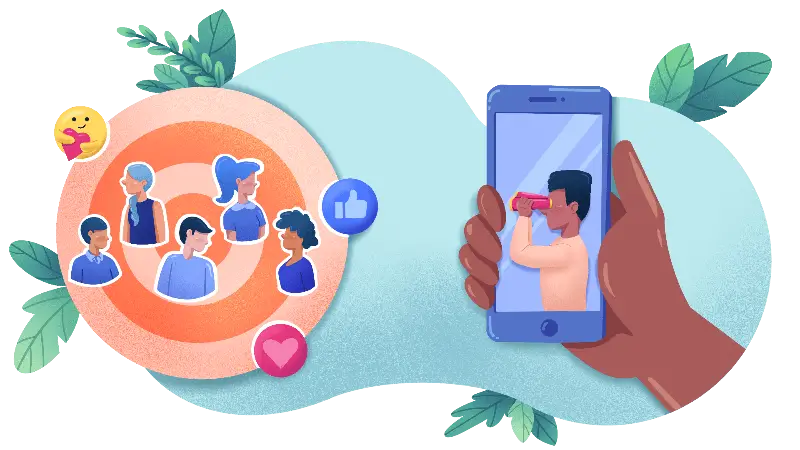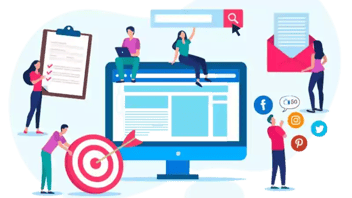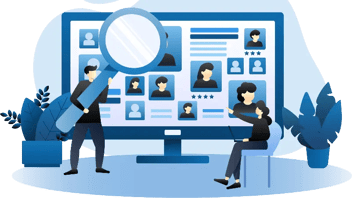Struggling to Reach Your Target Audience? You Need Buyer Personas
Marketing can feel like shouting into a vast, echoing canyon – you know you're putting the effort in, but are your ideal customers really hearing you? If your message isn't resonating, you're likely missing a key ingredient: buyer personas. These semi-fictional representations of your ideal customers go beyond basic demographics to paint a vivid picture of who you're trying to reach.
Let's explore how well-crafted buyer personas can transform your marketing from a shot in the dark to a precisely targeted strategy that delivers real results.
The Problem with Generic Marketing
Today, simply casting a wide net with your marketing efforts is no longer enough. Generic marketing, with its one-size-fits-all messaging, often misses the mark, failing to resonate with any specific target audience. It's like trying to hit a bullseye with your eyes closed–you might get lucky, but chances are you'll miss completely.
71% of consumers express frustration when faced with impersonal shopping experiences–this translates to wasted marketing spend and dismal engagement rates. Businesses pour resources into campaigns that yield minimal returns, their messages fading into the background noise of countless competing promotions.
Consider a hypothetical outdoor apparel company, "Adventure Co.," that opted for a generic marketing approach. Their advertisements featured generic images of models hiking and camping, accompanied by vague slogans like "Embrace the Outdoors." The result? Their message failed to resonate with specific outdoor enthusiast segments. Rock climbers felt uninspired by images of leisurely hikes, while experienced backpackers found the slogan too simplistic. Consequently, Adventure Co. saw low website traffic, minimal engagement on social media, and disappointing sales figures.
This scenario underscores a critical truth: generic marketing often leads to generic results. Without a clear understanding of who you're trying to reach, your message becomes diluted, failing to capture attention or drive conversions. It's like trying to appeal to everyone and ending up connecting with no one.
Understanding Your Ideal Customer
To truly connect with your audience, you need to move beyond broad demographics and delve deeper into the heart of who your ideal customer really is. Think of it as the difference between seeing a faint outline in the distance and having a face-to-face conversation. Understanding your ideal customer is about gaining crystal-clear clarity on their motivations, aspirations, and pain points.
This is why buyer personas matter. These detailed profiles go beyond simple demographics like age and location to encompass a rich tapestry of information that brings your ideal customer to life. Let's break down the key elements:
-
Demographics: While not the whole picture, demographics provide a foundational understanding. This includes age, gender, location, occupation, income, and education level.
-
Psychographics: This delves into the "why" behind your customer's actions. What are their values, interests, lifestyle preferences, and personality traits? What motivates them?
-
Buying behaviors: How do they typically make purchasing decisions? What channels do they prefer (online, in-store, social media)? Are they impulsive buyers or meticulous researchers?
-
Pain points and challenges: What keeps them up at night? What challenges do they face in their personal or professional lives?
-
Goals and aspirations: What are they striving for? What are their dreams and ambitions?
Let's illustrate with an example, bringing back our company "Adventure Co.” One of their buyer personas might be "Adventurous Alex":
-
Demographics: Alex is a 28-year-old software engineer living in Denver, Colorado. He's single with a disposable income that allows him to invest in his passion for outdoor activities.
-
Psychographics: Alex is an avid rock climber and hiker who thrives on challenging himself physically and exploring new terrains. He values high-quality gear, appreciates minimalist design, and enjoys sharing his adventures on social media.
-
Buying behaviors: Alex prioritizes performance and durability when purchasing outdoor apparel. He reads online reviews, seeks recommendations from fellow climbers, and is willing to invest in premium brands that offer reliable, long-lasting gear. He prefers shopping online or at specialty outdoor retailers.
-
Pain points: Alex struggles to find apparel that offers both performance and sustainability. He's frustrated with low-quality gear that wears out quickly and wants to minimize his environmental impact.
-
Goals: Alex aims to push his limits as a climber, explore new climbing destinations, and connect with a community of like-minded adventurers.
By understanding "Adventurous Alex," Adventure Co. can refine its marketing strategy. Instead of generic images and slogans, they can showcase their apparel in action on challenging climbs, highlight technical features and sustainable materials, and partner with climbing influencers to build credibility. They can also create content that speaks to Alex's desire for exploration and community, such as blog posts on climbing destinations or social media campaigns featuring user-generated content.
This targeted approach allows Adventure Co. to connect with Alex on a deeper level, demonstrating that they understand his needs and aspirations. This increases the likelihood of Alex choosing Adventure Co.'s apparel over competitors, fostering brand loyalty and driving sales.
Benefits of Using Buyer Personas
The role of buyer personas for startups serves as more than just descriptive profiles; they're powerful tools that can significantly elevate your marketing effectiveness. Think of them as a roadmap guiding you toward your target audience, helping you navigate the complexities of the marketing landscape with precision and purpose. They're similar to ideal customer profiles (ICP), with a slightly broader scope.
The impact of buyer personas is undeniable: personalized emails, crafted with a specific buyer persona in mind, deliver 6x higher transaction rates. This is just one example of how understanding your audience can translate to tangible results.
Let's delve into the specific benefits buyer personas bring to your marketing arsenal:
-
Targeted marketing campaigns: No more shooting arrows in the dark. Buyer personas provide the insights needed to create laser-focused campaigns that resonate with your ideal customers. You can tailor your messaging, channel selection, and even campaign timing to align with their preferences and behaviors.
-
Relevant content and messaging: Content is king, but only when it's relevant to your audience. Buyer personas help you create content that addresses their specific pain points, interests, and aspirations. This could include blog posts, social media updates, email newsletters, or even product demos – all crafted with a specific persona in mind.
-
Improved product development: By understanding your customers' needs and challenges, you can develop products and services that truly address their desires. This leads to greater customer satisfaction, increased sales, and reduced product development costs.
-
Increased conversion rates and ROI: When your marketing efforts are targeted and relevant, you're more likely to convert leads into customers. This translates to a higher return on your marketing investment (ROI) and a more efficient use of your resources.
-
Aligned marketing and sales efforts: Buyer personas bridge the gap between marketing and sales teams. Both teams can use these profiles to understand the customer journey, ensuring consistent messaging and a seamless experience throughout the sales funnel.
Overall, buyer personas empower you to make informed marketing decisions, ensuring your efforts are aligned with the needs and desires of your target audience. This leads to more effective campaigns, stronger customer relationships, and, ultimately, greater business success.
Creating Effective Buyer Personas
Creating effective buyer personas is a journey of discovery, a process of unearthing valuable insights about your ideal customers. It's like piecing together a puzzle, where each piece of information contributes to a clearer picture of who you're trying to reach. While it requires effort and dedication, the rewards are well worth the investment.
Here's a step-by-step guide to help you define your buyer personas:
Conduct Market Research and Gather Data
The foundation of any successful buyer persona is solid research. This involves gathering both quantitative and qualitative data from various sources:
-
Surveys: Create targeted surveys to gather information about your audience's demographics, preferences, and behaviors. Use tools like SurveyMonkey or Typeform to distribute your surveys and analyze the results.
-
Interviews: Conduct one-on-one interviews with existing or potential customers. These in-depth conversations provide rich qualitative data, allowing you to delve deeper into their motivations and pain points.
-
Analytics: Leverage website analytics, social media analytics, and CRM data to understand your audience's online behavior, engagement patterns, and purchase history.
Analyze Data to Identify Patterns and Segment Your Audience
Once you've gathered sufficient data, it's time to analyze it for recurring patterns and trends. Look for commonalities in demographics, psychographics, and behaviors. This will help you segment your audience into distinct groups with shared characteristics.
For example, you might discover that a significant portion of your customers are young professionals interested in sustainable living, while another segment consists of families seeking affordable and convenient solutions.
Develop Detailed Profiles for Each Persona
Now, it's time to bring your personas to life. For each segment, create a detailed profile that includes:
-
A descriptive name: Give your persona a memorable name that reflects their characteristics (e.g., "Sustainable Sarah," "Budget-Conscious Ben").
-
Demographics: Include relevant demographic information like age, location, occupation, income, and education.
-
Psychographics: Describe their values, interests, lifestyle, and personality traits.
-
Buying behaviors: Outline their purchase habits, preferred channels, and decision-making process.
-
Pain points and challenges: Identify their key challenges and frustrations.
-
Goals and aspirations: Describe their goals, ambitions, and what they hope to achieve.
Give Each Persona a Visual Representation
Adding a visual element to your personas makes them more engaging and memorable. Consider using stock photos or illustrations to represent each persona or create a simple avatar. This helps humanize your personas and makes them more relatable.
Share Personas Across Your Organization
Ensure your buyer personas are readily accessible to everyone in your organization, from marketing and sales to product development and customer service. This shared understanding fosters alignment and ensures everyone is working towards the same goals.
Put Your Personas in Action
Buyer personas aren't meant to gather dust on a shelf. They are dynamic tools that should infuse every aspect of your marketing strategy. Here's how to put them into action:
-
Content creation: "Adventurous Alex" might be drawn to blog posts about gear maintenance or videos showcasing climbers using your apparel in extreme conditions. "Budget-Conscious Ben," another potential persona, might respond better to articles on affordable outdoor adventures or social media posts highlighting sales and discounts.
-
Channel selection: LinkedIn might be ideal for reaching professionals like Alex, while Instagram could be more effective for connecting with younger outdoor enthusiasts. Consider where your personas spend their time online and focus your efforts accordingly.
-
Messaging and positioning: Alex might be drawn to messages emphasizing performance and durability, while Ben might prioritize value and affordability. Tailor your language and highlight features that resonate with each persona's unique motivations.
-
Product development: If your research reveals a need for more sustainable outdoor apparel, consider incorporating recycled materials or eco-friendly manufacturing processes into your product line. Use your personas to guide product development and ensure you're meeting the specific needs of your target market.
By weaving your buyer personas into these core marketing activities, you'll ensure your efforts are always aligned with the needs and desires of your ideal customers. This translates to more effective campaigns, stronger customer relationships, and a thriving business.
Take the Guesswork Out of Marketing with Buyer Personas
When it comes to marketing, one thing remains constant: the power of truly understanding your audience. Buyer personas provide the key to unlocking this understanding, transforming your marketing from a guessing game into a strategic pursuit. By investing the time and effort to create detailed buyer personas, you'll gain the insights needed to craft targeted campaigns, develop relevant content, and turn prospects into customers.
Ready to ditch the generic approach and embrace a marketing strategy that truly resonates? Start creating your buyer personas today. If you need a guiding hand in this journey, consider partnering with Aspiration Marketing.
You can transform your marketing efforts and achieve sustainable business growth with the right expertise, tools, and strategies. Contact us today!
This content is also available in:
- German: Zu schwierig, Ihre Zielgruppe zu erreichen? Nutzen Sie Buyer Personas
- Spanish: ¿Le cuesta llegar a su público objetivo? Necesita Buyer Personas
- French: Atteindre votre public cible : besoin de personas ?
- Italian: Pubblico difficile? Usa le Buyer Personas!
- Romanian: Public țintă greu de atins? Buyer Persona te ajută!
- Chinese: 难以接触目标受众?您需要买家角色










Leave a Comment